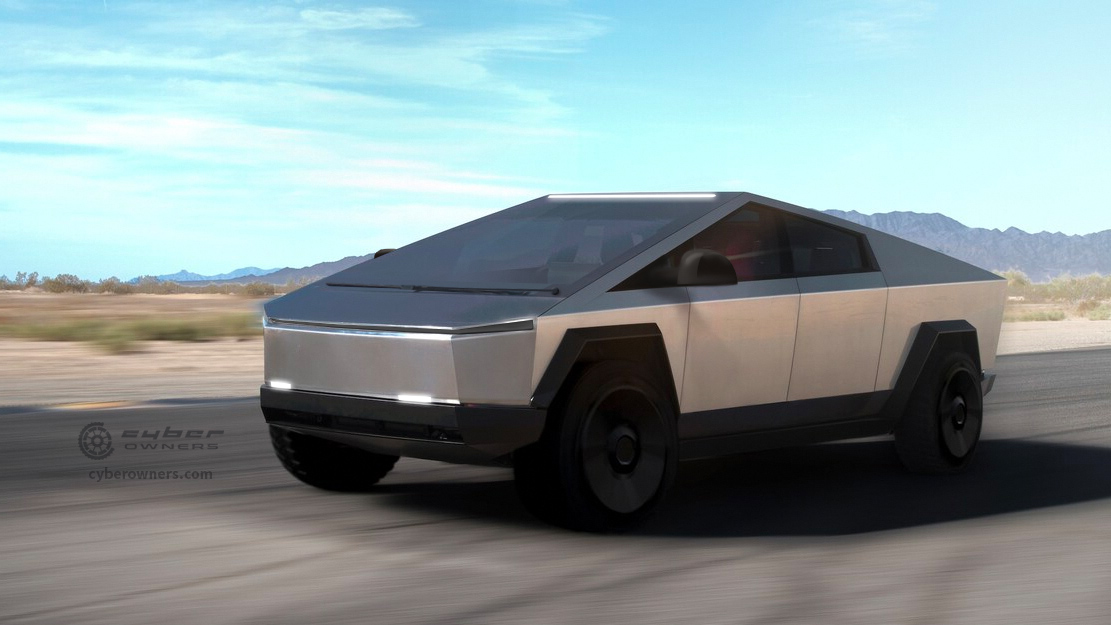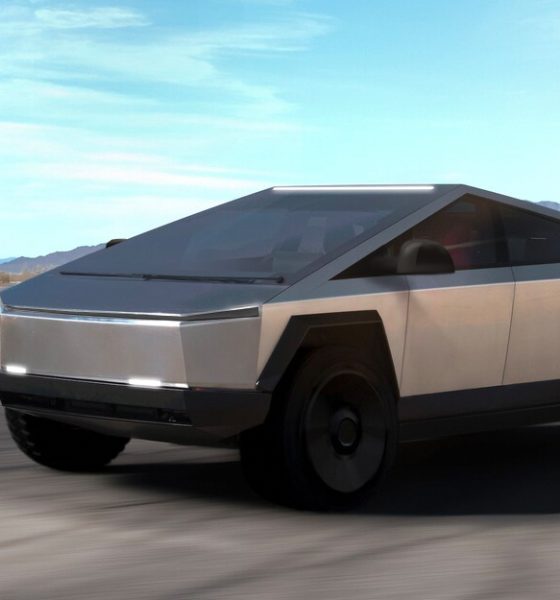

News
Tesla’s Product Roadmap update reveals Cybertruck, $25k Model won’t come in 2022
Tesla’s Earnings Call for Q4 and Full Year 2021 was its most impressive in history from a financial standpoint. After accomplishing its second profitable year of operations with a healthy automotive gross margin and above-consensus reports of production and delivery figures, Tesla activated bullish commentary across the board from many analysts and firms. However, the most anticipated portion of the call for some was Musk’s promise to update Tesla’s “Product Roadmap,” which revealed that “Cybertruck, Semi, Roadster, [and] Optimus” will not come until 2023 at the earliest.
“So, we will not be introducing new vehicle models this year,” Musk said on the call. “It would not make any sense because we’ll still be parts constrained.” Global supply chain issues have plagued much of the automotive industry. Tesla, interestingly, has been the one company that has seemingly defied all odds and avoided increasing wait times for even the most standard of parts. However, the company is not immune to the shortages, and 2022 will not be a year where Tesla introduces any new vehicles, including the Cybertruck, which was recently rumored to be pushed back to 2023.
It seems that reports were correct, and Tesla will not enter any explicit production phases of the Cybertruck, nor any of the other models Musk mentioned this year. The Roadster, Semi, and $25,000 rumored vehicle will not enter production any time during 2022. This does not mean that Tesla will not be developing them, however.
“We will, however, do a lot of engineering and tooling, whatnot to create those vehicles: Cybertruck, Semi, Roadster, Optimus, and be ready to bring those to production hopefully next year. That is most likely,” Musk added. He also indicated that the Tesla Bot, which is inching toward the name “Optimum Sub-Prime,” will be Tesla’s “most important product development” of 2022. “This, I think, has the potential to be more significant than the vehicle business over time.”
Joe Rogan gives the Tesla Cybertruck some praise: “Coolest car I’ve ever seen in my life”
While some (including myself) are frustrated with timeline delays, it is important to remember Tesla cannot control global supply constraints. While the company is super vertically-integrated, it cannot build its entire vehicles itself and has to receive some of its parts from third-party suppliers. This has limited Tesla’s ability to offer certain powertrains and has pushed back delivery dates on some currently offered models.
What about models that have been in Tesla’s pipeline for several years? The Cybertruck had an initial production date of late 2021 for the Tri-Motor powertrain. Now, the Tri-Motor will not even be the premier trim, according to Musk himself, who said a Quad-Motor variant would be the first Cybertruck model produced at Gigafactory Texas.
Tesla’s uber-affordable $25,000 model will also not be coming anytime soon, although he confirmed it. “Well, we’re not currently working on the — on a $25,000 car. We — you know, at some point, we will, but we have enough on our plate right now, too much on our plate, frankly. So, you know, at some point, there will be.”
The Q4 2021 Earnings Call really told us all one thing: the good stuff is coming next year. This year will be a year of surviving the supply chain shortage, which Musk also stated would last through this year. “So — in 2022, supply chain will continue to be the fundamental limiter of output across all factories. So the chip shortage, while better than last year, is still an issue.” After Tesla works through short-term issues with the supply chain bottlenecks, the company’s longer-term projects can move forward, bringing more groundbreaking and innovative electric vehicles to the market.
I’d love to hear from you! If you have any comments, concerns, or questions, please email me at joey@teslarati.com. You can also reach me on Twitter @KlenderJoey, or if you have news tips, you can email us at tips@teslarati.com.
Quotes provided by The Motley Fool.

Elon Musk
Elon Musk and Tesla AI Director share insights after empty driver seat Robotaxi rides
The executives’ unoccupied tests hint at the rapid progress of Tesla’s unsupervised Robotaxi efforts.

Tesla CEO Elon Musk and AI Director Ashok Elluswamy celebrated Christmas Eve by sharing personal experiences with Robotaxi vehicles that had no safety monitor or occupant in the driver’s seat. Musk described the system’s “perfect driving” around Austin, while Elluswamy posted video from the back seat, calling it “an amazing experience.”
The executives’ unoccupied tests hint at the rapid progress of Tesla’s unsupervised Robotaxi efforts.
Elon and Ashok’s firsthand Robotaxi insights
Prior to Musk and the Tesla AI Director’s posts, sightings of unmanned Teslas navigating public roads were widely shared on social media. One such vehicle was spotted in Austin, Texas, which Elon Musk acknowleged by stating that “Testing is underway with no occupants in the car.”
Based on his Christmas Eve post, Musk seemed to have tested an unmanned Tesla himself. “A Tesla with no safety monitor in the car and me sitting in the passenger seat took me all around Austin on Sunday with perfect driving,” Musk wrote in his post.
Elluswamy responded with a 2-minute video showing himself in the rear of an unmanned Tesla. The video featured the vehicle’s empty front seats, as well as its smooth handling through real-world traffic. He captioned his video with the words, “It’s an amazing experience!”
Towards Unsupervised operations
During an xAI Hackathon earlier this month, Elon Musk mentioned that Tesla owed be removing Safety Monitors from its Robotaxis in Austin in just three weeks. “Unsupervised is pretty much solved at this point. So there will be Tesla Robotaxis operating in Austin with no one in them. Not even anyone in the passenger seat in about three weeks,” he said. Musk echoed similar estimates at the 2025 Annual Shareholder Meeting and the Q3 2025 earnings call.
Considering the insights that were posted Musk and Elluswamy, it does appear that Tesla is working hard towards operating its Robotaxis with no safety monitors. This is quite impressive considering that the service was launched just earlier this year.
Elon Musk
Starlink passes 9 million active customers just weeks after hitting 8 million
The milestone highlights the accelerating growth of Starlink, which has now been adding over 20,000 new users per day.

SpaceX’s Starlink satellite internet service has continued its rapid global expansion, surpassing 9 million active customers just weeks after crossing the 8 million mark.
The milestone highlights the accelerating growth of Starlink, which has now been adding over 20,000 new users per day.
9 million customers
In a post on X, SpaceX stated that Starlink now serves over 9 million active users across 155 countries, territories, and markets. The company reached 8 million customers in early November, meaning it added roughly 1 million subscribers in under seven weeks, or about 21,275 new users on average per day.
“Starlink is connecting more than 9M active customers with high-speed internet across 155 countries, territories, and many other markets,” Starlink wrote in a post on its official X account. SpaceX President Gwynne Shotwell also celebrated the milestone on X. “A huge thank you to all of our customers and congrats to the Starlink team for such an incredible product,” she wrote.
That growth rate reflects both rising demand for broadband in underserved regions and Starlink’s expanding satellite constellation, which now includes more than 9,000 low-Earth-orbit satellites designed to deliver high-speed, low-latency internet worldwide.
Starlink’s momentum
Starlink’s momentum has been building up. SpaceX reported 4.6 million Starlink customers in December 2024, followed by 7 million by August 2025, and 8 million customers in November. Independent data also suggests Starlink usage is rising sharply, with Cloudflare reporting that global web traffic from Starlink users more than doubled in 2025, as noted in an Insider report.
Starlink’s momentum is increasingly tied to SpaceX’s broader financial outlook. Elon Musk has said the satellite network is “by far” the company’s largest revenue driver, and reports suggest SpaceX may be positioning itself for an initial public offering as soon as next year, with valuations estimated as high as $1.5 trillion. Musk has also suggested in the past that Starlink could have its own IPO in the future.
News
NVIDIA Director of Robotics: Tesla FSD v14 is the first AI to pass the “Physical Turing Test”
After testing FSD v14, Fan stated that his experience with FSD felt magical at first, but it soon started to feel like a routine.

NVIDIA Director of Robotics Jim Fan has praised Tesla’s Full Self-Driving (Supervised) v14 as the first AI to pass what he described as a “Physical Turing Test.”
After testing FSD v14, Fan stated that his experience with FSD felt magical at first, but it soon started to feel like a routine. And just like smartphones today, removing it now would “actively hurt.”
Jim Fan’s hands-on FSD v14 impressions
Fan, a leading researcher in embodied AI who is currently solving Physical AI at NVIDIA and spearheading the company’s Project GR00T initiative, noted that he actually was late to the Tesla game. He was, however, one of the first to try out FSD v14.
“I was very late to own a Tesla but among the earliest to try out FSD v14. It’s perhaps the first time I experience an AI that passes the Physical Turing Test: after a long day at work, you press a button, lay back, and couldn’t tell if a neural net or a human drove you home,” Fan wrote in a post on X.
Fan added: “Despite knowing exactly how robot learning works, I still find it magical watching the steering wheel turn by itself. First it feels surreal, next it becomes routine. Then, like the smartphone, taking it away actively hurts. This is how humanity gets rewired and glued to god-like technologies.”
The Physical Turing Test
The original Turing Test was conceived by Alan Turing in 1950, and it was aimed at determining if a machine could exhibit behavior that is equivalent to or indistinguishable from a human. By focusing on text-based conversations, the original Turing Test set a high bar for natural language processing and machine learning.
This test has been passed by today’s large language models. However, the capability to converse in a humanlike manner is a completely different challenge from performing real-world problem-solving or physical interactions. Thus, Fan introduced the Physical Turing Test, which challenges AI systems to demonstrate intelligence through physical actions.
Based on Fan’s comments, Tesla has demonstrated these intelligent physical actions with FSD v14. Elon Musk agreed with the NVIDIA executive, stating in a post on X that with FSD v14, “you can sense the sentience maturing.” Musk also praised Tesla AI, calling it the best “real-world AI” today.








